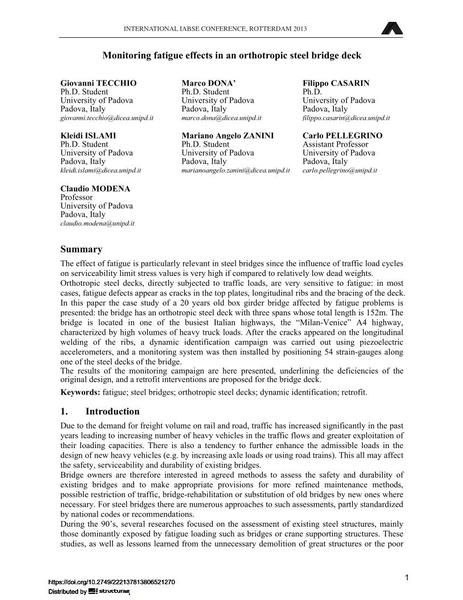Monitoring fatigue effects in an orthotropic steel bridge deck

|
|
|||||||||||
Bibliographic Details
| Author(s): |
Giovanni Tecchio
Marco Dona' Filippo Casarin Kleidi Islami Mariano Angelo Zanini Carlo Pellegrino Claudio Modena |
||||
|---|---|---|---|---|---|
| Medium: | conference paper | ||||
| Language(s): | English | ||||
| Conference: | IABSE Conference: Assessment, Upgrading and Refurbishment of Infrastructures, Rotterdam, The Netherlands, 6-8 May 2013 | ||||
| Published in: | IABSE Conference, Rotterdam, May 2013 | ||||
|
|||||
| Page(s): | 506-507 | ||||
| Total no. of pages: | 8 | ||||
| Year: | 2013 | ||||
| DOI: | 10.2749/222137813806521270 | ||||
| Abstract: |
The effect of fatigue is particularly relevant in steel bridges since the influence of traffic load cycles on serviceability limit stress values is very high if compared to relatively low dead weights. Orthotropic steel decks, directly subjected to traffic loads, are very sensitive to fatigue: in most cases, fatigue defects appear as cracks in the top plates, longitudinal ribs and the bracing of the deck. In this paper the case study of a 20 years old box girder bridge affected by fatigue problems is presented: the bridge has an orthotropic steel deck with three spans whose total length is 152m. The bridge is located in one of the busiest Italian highways, the “Milan-Venice” A4 highway, characterized by high volumes of heavy truck loads. After the cracks appeared on the longitudinal welding of the ribs, a dynamic identification campaign was carried out using piezoelectric accelerometers, and a monitoring system was then installed by positioning 54 strain-gauges along one of the steel decks of the bridge. The results of the monitoring campaign are here presented, underlining the deficiencies of the original design, and a retrofit interventions are proposed for the bridge deck. |
||||
| Keywords: |
fatigue orthotropic steel decks steel bridges retrofit dynamic identification
|
||||
